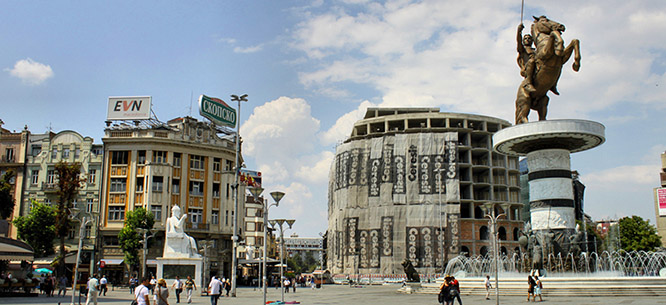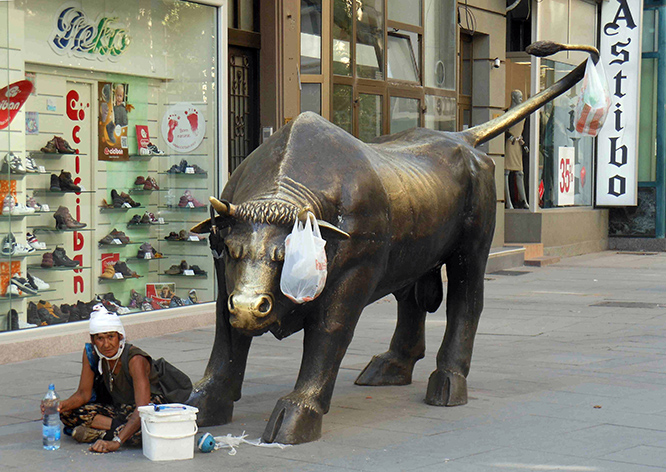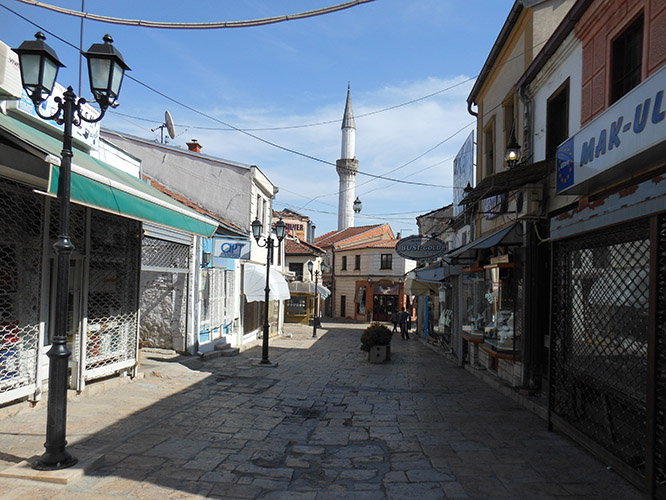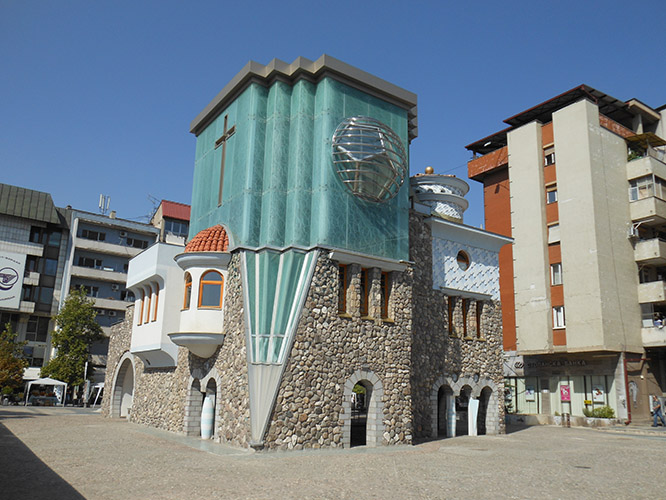Show Us Your Country: Macedonia’s Capital Transformed
Show Us Your Country: Macedonia’s Capital Transformed
At a cost of several hundred millions of euros, the capital of Macedonia is undergoing a makeover that includes one of the largest statues in Europe, a new archaeological museum, and several works of public art, all financed by the government in an effort to paint their poverty-stricken state as the rightful inheritor of a distant grandeur. Critics have wondered whether the money could not be better spent in a country that, if it were to join the EU, would be the poorest member.

Until recently, the city of Skopje in the former Yugoslavia was known, among those interested in urban development, largely for a single event: the 1963 earthquake that all but leveled the city. But today, under a nationalist government seeking to assert the country’s ancient history with Donald Trump–like bravado, the capital of Macedonia has come back on the architectural radar. Skopje’s ongoing makeover, at a cost of several hundred million euros, includes one of the largest statues in Europe, a new archaeological museum, and several works of public art, all financed by the government in an effort to paint their poverty-stricken state as the rightful inheritor of a distant grandeur. The problem is that history, even ancient history, is anything but uncontested in the Balkans.
Macedonia, like nearby Bosnia, is a young state fighting against wary neighbors for political recognition, ownership of historical figures, and linguistic autonomy. While it was spared the carnage of the Yugoslav wars of the 1990s, the country has encountered its own set of problems since achieving independence from the former federal republic in 1991: Greece contests Macedonia’s very right to exist under its current name; Bulgarian political organizations, often associated with the far right, claim Slavic Macedonians as their own; and Macedonia’s current right-wing government has almost no support from the country’s ethnic Albanians, who make up a quarter of the population. In the face of these perceived threats, both internal and external, the Macedonian authorities are seeking to shore up national identity by any means possible.
Skopje has become the ground zero of this struggle. The central plaza, which used to sport only modest flowerbeds, is now home to an eight-story-tall fountain and statue of Alexander the Great. Alexander, who is officially named “Warrior on a Horse,” raises his sword to the sky as his horse rears up on its hind legs; they appear poised to protect the city from imminent danger. Across the Vardar River, an equally large sculpture of Alexander’s father, Philip II of Macedon, was recently erected. Both are part of the Skopje 2014 plan—an ambitious, and largely aesthetic, remodeling of both Skopje and Macedonian nationalism with an estimated budget of 200 to 500 million euros. The plan owes its vigor to Macedonia’s forty-three-year-old prime minister Nikola Gruevski, who has been governing a center-right coalition since he was in his mid-thirties and wishes to present an equally fresh-faced capital to the European Union.
While heritage tourism has been a powerful economic buzzword in the countries of the European periphery for some time, this project goes a step further: it is an emphatic response to regional neighbors who have defied Macedonia to “show us your country” and an attempt to claim an autonomous national story that predates both Yugoslavia and the Ottoman Empire. The struggle just to defend the country’s name against the implacable Greek government has kept classics scholars busy for a decade, and now their work has spilled into public space. Yet even in Macedonia, the capital’s new face has not been uniformly embraced: architects have derided the makeover as garish, NGOs have called it a nepotistic money grab, and many wonder whether such a lavish outlay of capital could be better spent in a country that, if it were to join the EU, would be the poorest member.
The Battle for Historical Symbols
Modern Macedonia was first “imagined”—to borrow Benedict Anderson’s term—around the turn of the twentieth century, when the freedom fighters of the Internal Macedonian Revolutionary Organization (IMRO) launched a guerrilla war against their Ottoman rulers. But the notion of a Macedonian nation-state was disputed from the start. The insurgents were divided most notably over the question of fusion with Macedonia’s northern neighbor Bulgaria, which is quite similar ethnically and linguistically; when the pro-independence faction eventually won out, Bulgaria became a political rival and seat of anti-Macedonian resentment. (To this day, a splinter group of the IMRO exists in Bulgaria and operates as a right-wing political party, insisting that Slavic Macedonians do not speak a distinct language from Bulgarian and are ethnically Bulgarian.)
To illustrate one of the current disputes: Bulgaria’s most prominent university is named after St. Clement Ohridski, while Macedonia’s is named after Cyril and Methodius. The latter were the originators of the Cyrillic alphabet and the former was their disciple; all three were based in the present-day Macedonian city of Ohrid, which was historically part of the Bulgarian kingdom. As a result, the Cyrillic alphabet—conceivably a source of pan-Slavic unity—is instead a flash point of contestation, with academics, opinion writers, and tour guides across the region all jousting to claim it for their respective countries.
More problematically for Macedonia, its very name is subject to a different, and more heated, historical dispute with neighboring Greece, which has a northern region of the same name. This area—whose hub, Thessaloniki, is Greece’s second largest city—was severed from the country Macedonia during the dissolution of the Ottoman Empire. However, disputes over the territory go back much farther, revolving around the ancient kingdom of Macedon and just how “Greek” it really was.
In its effort to simultaneously reclaim its ancient past and present itself as “open for business” in a neoliberal marketplace, the Skopje 2014 project is testing a formula for nation-branding that may yet prove rewarding.
This argument has not been as polite as the dispute over Cyrillic. In 2008, Greece used its EU status to cow NATO into refusing Macedonia admission and has similarly threatened to block its neighbor’s entrance into the European Union. Currently, most countries recognize Macedonia as the “Republic of Macedonia,” but Greece still refers to it, more diminutively, as the “Former Yugoslav Republic of Macedonia”—which to some Greek nationalists is still an unwise submission to the country’s supposed irredentist ambitions. The dispute got so heated that, in 1997, Cambridge University Press canceled the publication of a historical ethnography of Greek Macedonia for fear of the safety of its employees in Greece; the ethnography described people in northern Greece as culturally heterogeneous. Greeks living in the region of Macedonia, however, seem to care less about their neighbor’s name than about the future of their own economically blighted country, and in such cases have largely dismissed their government as reacting hysterically. Nevertheless, in light of such disputes and its exclusion from NATO, it’s not hard to understand the Macedonian government’s desire for symbolic retaliation. But it remains unclear whether the country’s newfound cultural bombast will curry favor with the EU—or aggravate tensions further.
The third ethnic complication involves the national split between Muslim Albanians and Orthodox Slavs. Although it escaped the Yugoslav wars largely unscathed, Macedonia did absorb a large refugee population of ethnic Albanians from Kosovo in 1999. These joined the country’s large Albanian minority (currently estimated at more than 25 percent of the total population) and constitute, in the eyes of Macedonian nationalist politicians, an internal threat on par with the external one posed by Greece and Bulgaria. The Skopje 2014 project, then, can be understood as both a gesture of defiance against unfriendly neighbors and a proclamation of Slavic and classical—rather than Albanian or Ottoman—heritage.
In rejecting this second strand of heritage, the Macedonian authorities are dismissing some of Skopje’s liveliest neighborhoods, for example the Stara Skopska često (Old Bazaar), which is connected to Macedonia Square—the hub of the Skopje 2014 plan—by the Ottoman-era Stone Bridge (its official name). The bazaar’s entrance has been anchored by a plethora of new statues, but inside, little change has taken place: stores still sell everything from gold to baklava to cut-rate school supplies. Signs of touristic gentrification are minimal. Evidently the Skopje authorities, with their eyes set toward erecting symbols of national pride, do not see a functioning, slightly decrepit series of winding streets and markets, most frequented by ethnic non-Slavs, as something to put on a pedestal—perhaps to the neighborhood’s benefit. In the absence of government support, the old bazaar has attracted younger entrepreneurs who have set up bars, stores, and restaurants betting on the appeal of actual historic places rather than super-sized representations of history.
Much of the Skopje 2014 project is premised on reclaiming ancient history through distinct national artifacts that can be flung at adversaries in the protracted battle over patrimony. Yet, it also seeks to make the city a marketable European destination, in light of a surge in niche tourism—heritage, cultural, culinary, rural—that has taken hold across the continent as industrial possibilities fade. With tourists becoming more mobile (through a growing network of low-cost airlines) and more intrepid (think post-conflict tourism, like in neighboring Bosnia), city governments are searching for their niche. One of the crown jewels of the Skopje project is an archaeological museum that is presumably meant to stand up to illustrious counterparts such as the British Museum and the Hermitage, which serve as urban icons and help to educate citizens about antiquity. The museum is, to be sure, an imposing building, fronted with Ionic columns and topped with gold domes. Connected to Macedonia Square by a purpose-built bridge jammed with sculptures, the museum suggests more Las Vegas hotel than repository of national heritage.
Post-Communist Kitsch
Is Skopje’s transformation representative of a broader post-socialist pattern? Like its neighbors in the former Eastern Bloc, Macedonia is dotted with the famous prefabricated blocks that have now become the very symbol of Eastern European urbanism. While Yugoslavia was quite supportive of artistic freedom when compared to nearby Romania or Bulgaria, it still dabbled in constructivism when it came to public buildings and housing. (Before Skopje 2014, one of the city’s most notable buildings was the Central Post Office, rendered in concrete and resembling either a garish socialist spaceship or the bud of an opening flower, depending on one’s perspective.) Some have argued that Skopje’s post-1989 architecture, like that of other cities seeking to reply directly to the socialist precedent, has been consciously exuberant: color, a variety of historical styles, and the lavish use of expensive materials have all been employed to celebrate the transition to capitalism. The rise of shopping malls, villas, and generously embellished public monuments represent, to some, the limitless aspirations of the post-1989 era and, to others, the utter implosion of cultural values.
But sometimes even the showiest buildings carry subtle political messages. A good example of the post-communist drive toward aesthetic immoderation is the Mother Teresa Memorial House—built in 2009, also by the Gruevski government—which aims to evoke the playfulness of architects like Michael Graves but falls flat, a seemingly inappropriate memorial to someone who devoted her life to selflessly helping the poor. The monument is more effective as a political point for Gruevski, who can lay claim to the accomplishments of Macedonian Albanians like Mother Teresa—born Anjezë Gonxhe Bojaxhiu—while keeping the national narrative within a Christian (although not exclusively Orthodox) framework.
It’s all too easy to write off this brand of architecture on grounds of taste—and indeed, both Macedonian and foreign critics have complained of the Skopje 2014 project’s “Disneyfication” of the city. Often, new architecture in post-socialist cities is derided by visitors not just for ugliness but for a specific kind of ugliness, with its shoddy execution of post-modernism and ostentatious gravitation toward neoclassicism. Almost inevitably, though, arguments over kitsch architecture are linked to education and class. As critics such as Pierre Bourdieu have pointed out, the assignation of aesthetic value has historically reflected the taste of people with money and power. Skopje is no exception. Much of the opposition to the city’s bejeweling with monuments, fountains, and sculptures has come from the well-educated and left-leaning quadrants of society.
Those who object to the perceived garishness of the renovations in Skopje, however, do so not only on grounds of taste but also on the evidence of its social cost. The budget and allocation of funds for Skopje 2014 are far from transparent, and the project appears to follow a well established template for corruption. Macedonian journalists and NGOs have widely accused Gruevski’s government of using the project as a giant slush fund to reward party loyals with extravagant contracts—only small parts of which, allegedly, are used on urban development. Meanwhile the unemployment rate in Macedonia is 31 percent and the country’s official GDP per capita is $10,700 annually. This places it in the unfortunate position of combining southern Europe’s unemployment problem with the Balkans’ extremely low and largely stagnant wages. Some peripheral countries, like Poland and the Czech Republic, have sought to combat such problems with a concerted push for reskilling of labor and continued investment in industry, in the hopes that regional cohesion will mean that manufacturing jobs go to places with lower wages. Macedonia is not one of these countries. Instead, it seems to have bet on the model of tourism and construction, in the hopes that cultural capital will attract cold, hard foreign cash.
Will the gamble pay off? In its effort to simultaneously reclaim its ancient past and present itself as “open for business” in a neoliberal marketplace, the Skopje 2014 project is testing a formula for nation-branding that may yet prove rewarding. Its reliance on symbols of a coherent past—albeit super-sized—suggest a certain savvy in soft-power statesmanship, avoiding bellicose nationalism in a bid as much for outside spectatorship as internal resolution.
It seems the most important verdict on Macedonia’s development plan will come from the EU, which has recently emerged as the main arbiter of the country’s future. Unlike in the case of Serbia, where war crimes prosecutions have been a major and tangible stumbling block to EU ascension, Macedonia must play a far more subtle game of courtship that relies on less tangible, and perhaps more superficial, forms of change. Its current push for continental recognition is well timed: the European Union is quite open to new member states, particularly ones in the Balkans, where history shows the perils of regional disunity and the prospect of post-socialist cohesion reaffirms a key goal of the EU. The compromised position of Greece, furthermore, is clearly advantageous to Macedonian ambitions; in the throes of economic crisis, Greece is incapacitated not only financially but also politically, having become a moral scapegoat for wider continental troubles. Macedonia may just be poised, then, to free itself from un-neighborly disputes and find its place in the European market, even as it shores up its own sense of national identity. Whether the country’s makeover will be conducive to a sustainable and equitable economy, however, is another question.
Max Holleran is a Ph.D. candidate in sociology at New York University.
All inline photos courtesy of the author.







